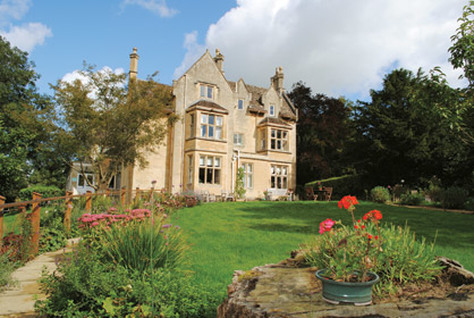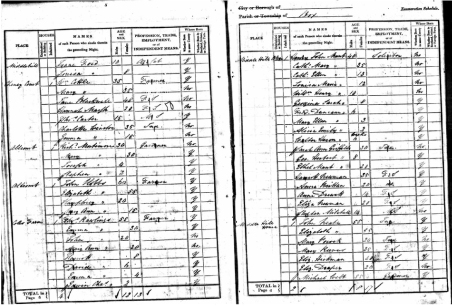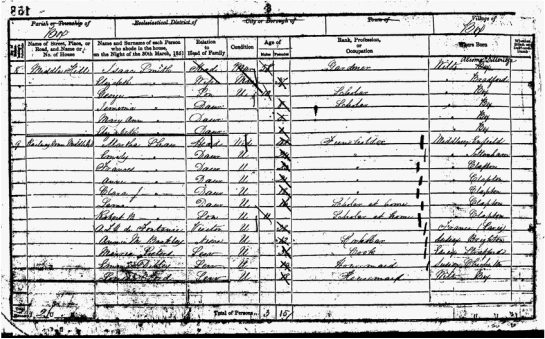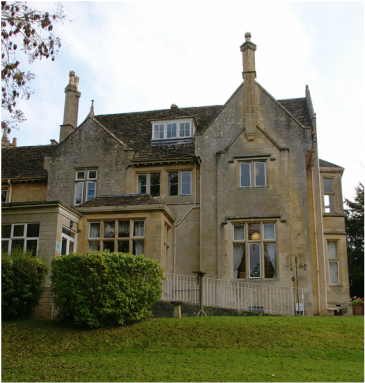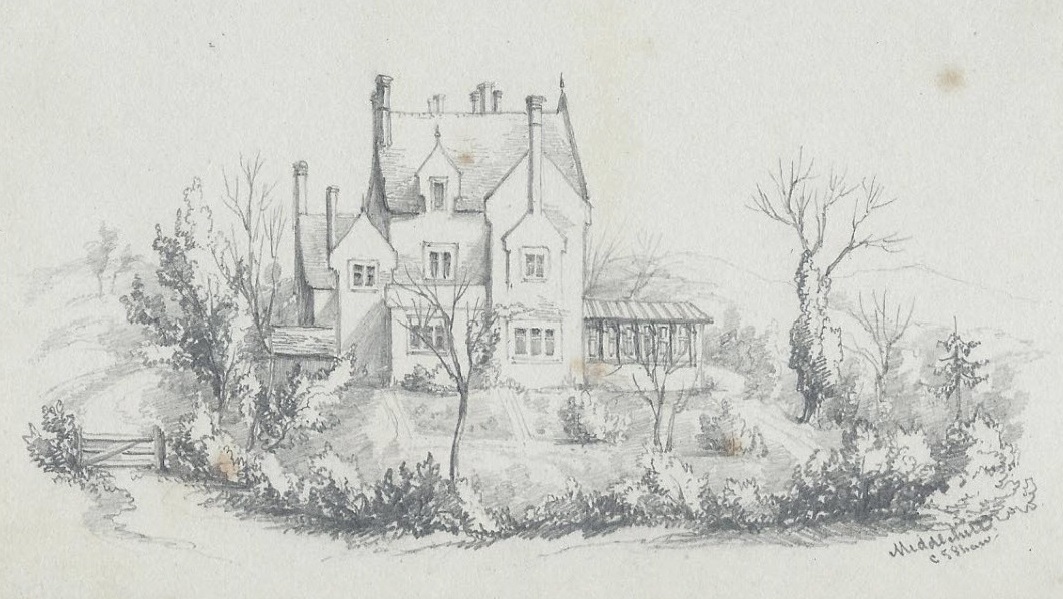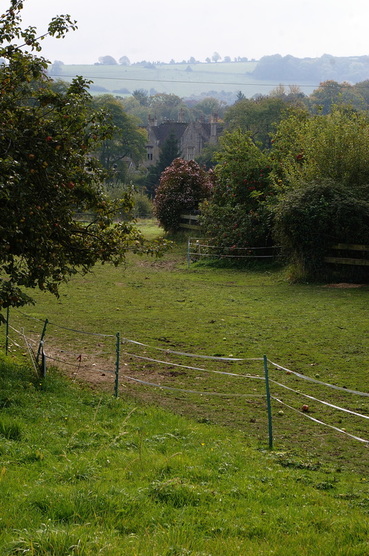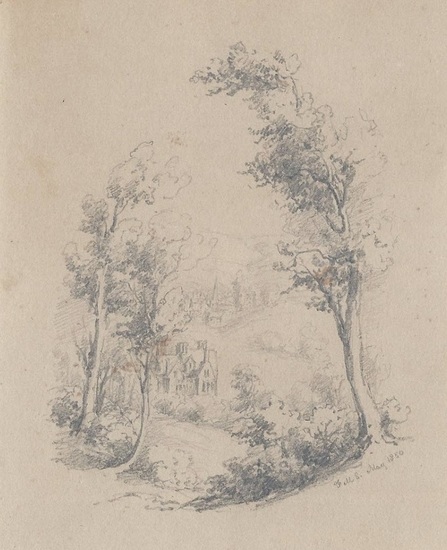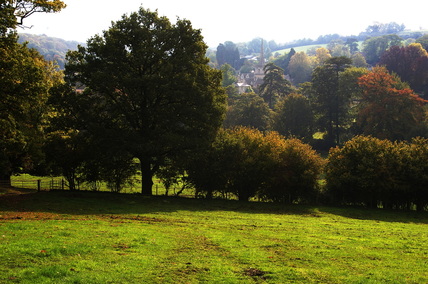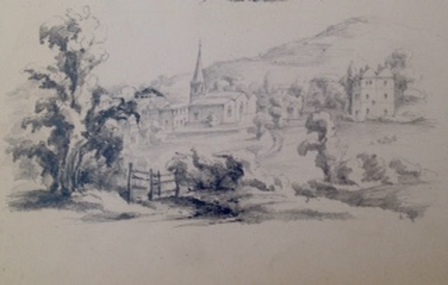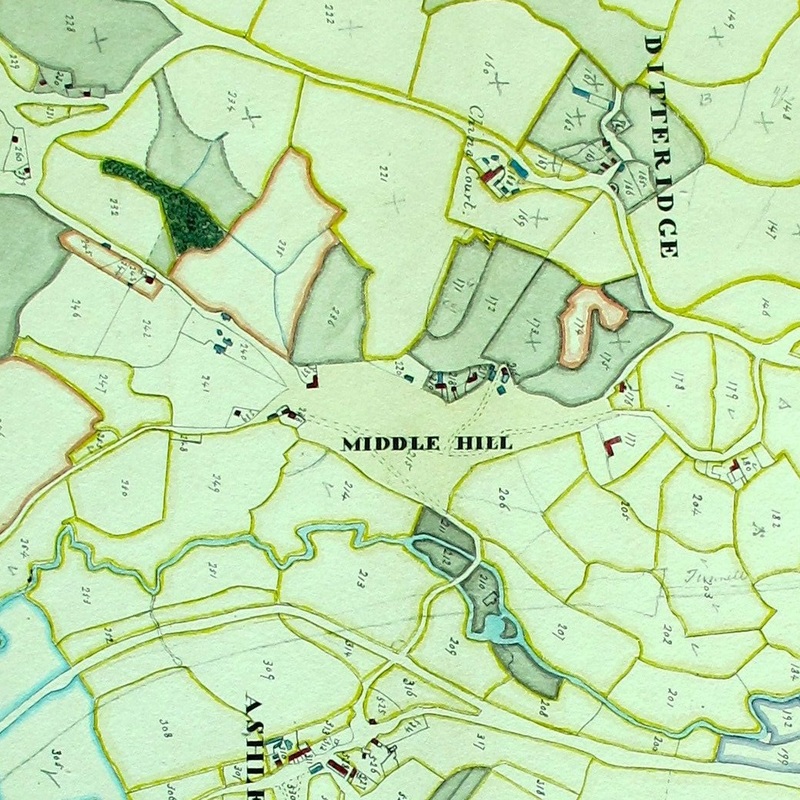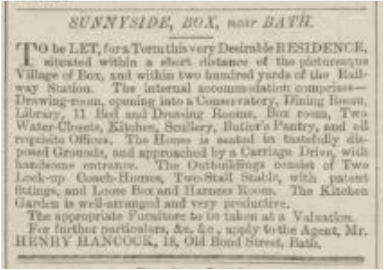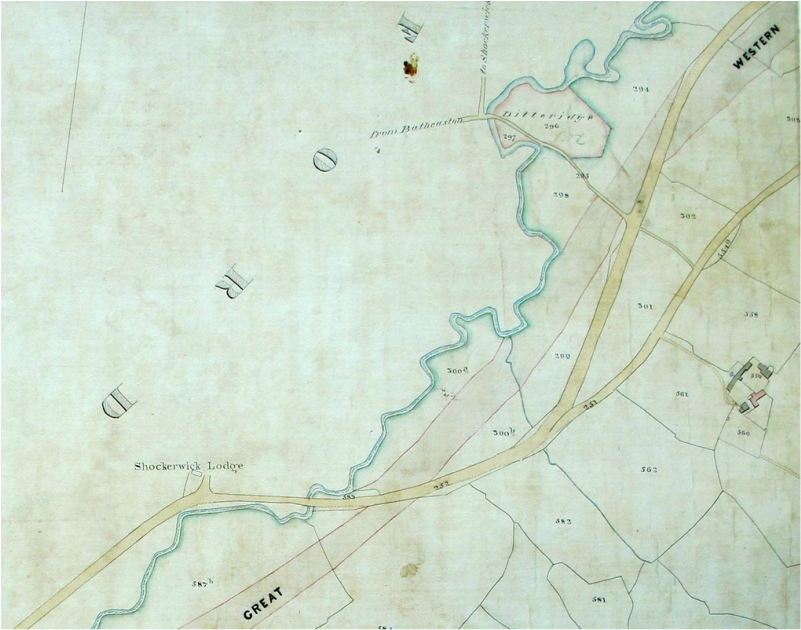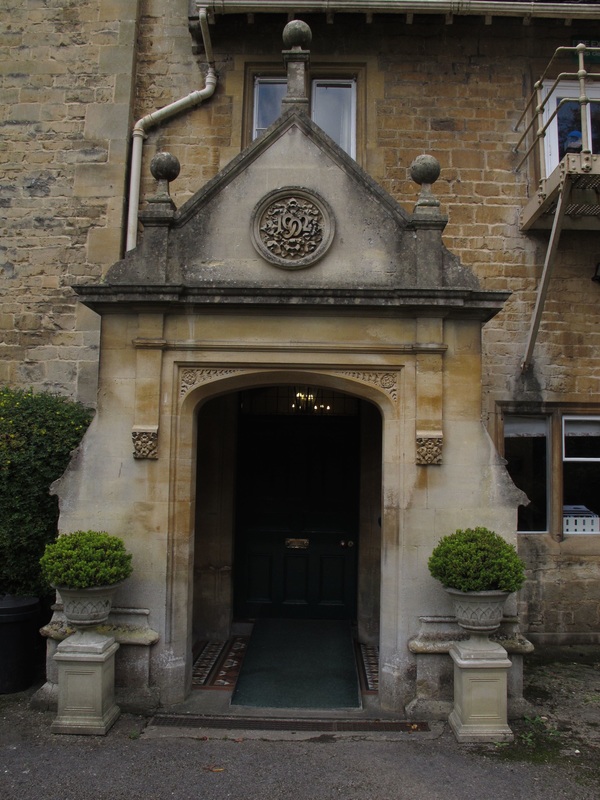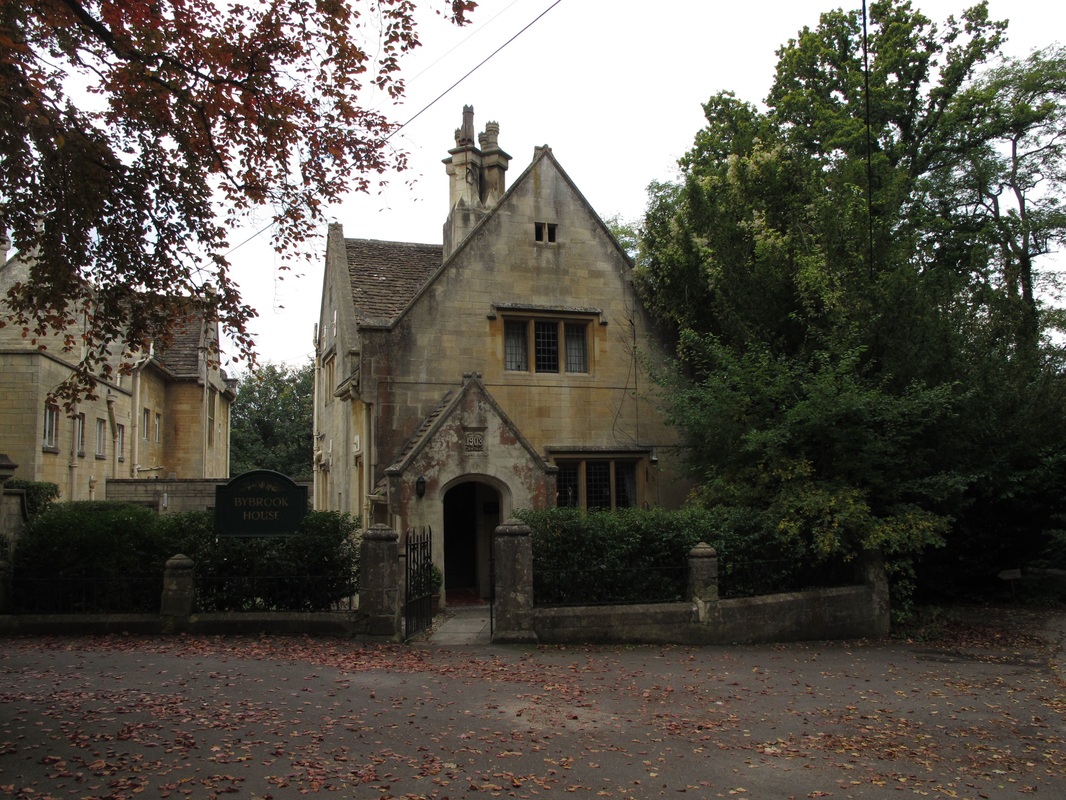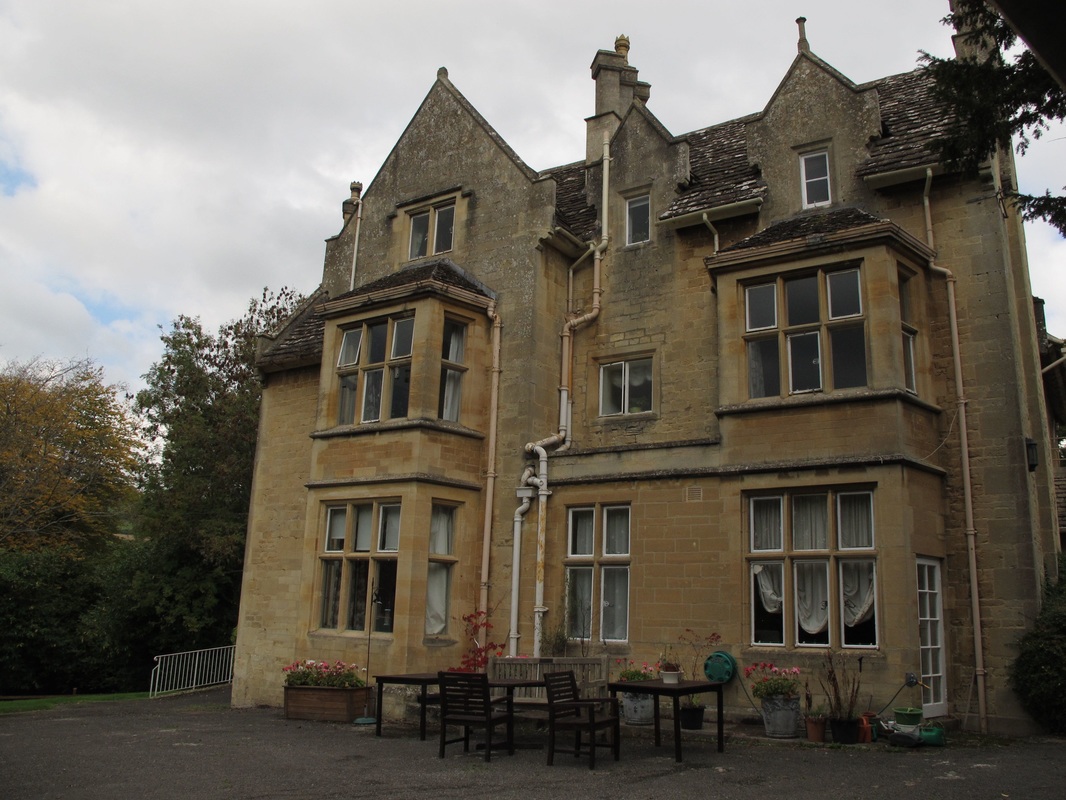|
Railway House, Sunnyside,
Holy Innocents and ByBrook House Original Research by Martin Devon November 2015 This is the story of a single house which has had several different names and uses. In 1850 it was the residence of Martha Shaw and her family recalled in the stories Railway House and Middlehill house hunting. Modern photos Martin Devon (unless stated otherwise) |
We asked in the earlier issues if you could help find Martha Shaw's house in 1850. Martin Devon has managed to trace the residence and here is his amazing research and conclusion about the property Martha called "Middlehill". He concludes that the house has undergone various facelifts and new names in the last 170 years: "Railway House", "Sunnyside", "Holy Innocents" and "ByBrook House". This is a brief history of those times.
Martha Shaw's Story: Identifying the Properties
Martha's house is indisputably now part of ByBrook House, formerly called Sunnyside, although it seems to have had the name Railway House before then. Although the property now appears a late Victorian building there is a much earlier core.
In the 1841 census (below left) the Mant family were living at Middlehill between Holbutts and Middlehill House (occupied by the Neates), going east. In the 1851 census it was enumerated the other way, and after Middlehill House (still Neates) Martha Shaw was at Railway House on the way to Holbutts. The Mant family, having let Railway House, was living at Shrub Hill House. The Mants were a family of solicitors in Bath, who sometimes dealt with the letting of properties as reported in the Bath Chronicle of
3 July 1845, Particulars and key from Messrs Mant and Harvey, Solicitors, 2 Wood Street, Bath. Madeleine added that Laura’s husband George John Robertson was a solicitor or partner in the firm of Mant, Maule and Robertson in 1863.
Martha's house is indisputably now part of ByBrook House, formerly called Sunnyside, although it seems to have had the name Railway House before then. Although the property now appears a late Victorian building there is a much earlier core.
In the 1841 census (below left) the Mant family were living at Middlehill between Holbutts and Middlehill House (occupied by the Neates), going east. In the 1851 census it was enumerated the other way, and after Middlehill House (still Neates) Martha Shaw was at Railway House on the way to Holbutts. The Mant family, having let Railway House, was living at Shrub Hill House. The Mants were a family of solicitors in Bath, who sometimes dealt with the letting of properties as reported in the Bath Chronicle of
3 July 1845, Particulars and key from Messrs Mant and Harvey, Solicitors, 2 Wood Street, Bath. Madeleine added that Laura’s husband George John Robertson was a solicitor or partner in the firm of Mant, Maule and Robertson in 1863.
Click on the illustrations above to enlarge the extracts of left 1841 census and right 1851 census (courtesy Ancestry.com).
In confirmation you can see that a current photograph of the South-West corner of ByBrook House incorporates the same characteristic detail drawn by Martha's daughter Clara Jane in 1850.
The Other Sketches
The sketch of the house (below right) with Box beyond cannot be from the northern side of the By Brook as there is neither rising ground nor a suitable line of sight. So by brook Martha must mean the trickle which comes off Middlehill Common and runs through Toad Hall to the west. The photo below left is taken near the entrance to Holbutts Farm and gives the correct alignment.
The sketch of the house (below right) with Box beyond cannot be from the northern side of the By Brook as there is neither rising ground nor a suitable line of sight. So by brook Martha must mean the trickle which comes off Middlehill Common and runs through Toad Hall to the west. The photo below left is taken near the entrance to Holbutts Farm and gives the correct alignment.
The view of Box House and Box Church (below right) is taken from the field below Hill House Farm, almost on the line of
Middlehill Tunnel. The photograph (below left) shows nearly the same view but Box House is largely obscured. The gate is in the same position.
Middlehill Tunnel. The photograph (below left) shows nearly the same view but Box House is largely obscured. The gate is in the same position.
Origins of the Name Railway House
The name Railway House, where Martha and her family lived in 1850, is interesting. The name clearly reflects the opening of the railway line in 1841 but raises questions about the location of the line and the position of the station outside of Box village.
There is an idea that Box Railway Station was built a mile west of the village for the convenience of a director or similar of the GWR who lived at the property. The Tithe Apportionment map of the area below shows how the area had developed with the line of Middlehill Tunnel drawn in pencil.
The name Railway House, where Martha and her family lived in 1850, is interesting. The name clearly reflects the opening of the railway line in 1841 but raises questions about the location of the line and the position of the station outside of Box village.
There is an idea that Box Railway Station was built a mile west of the village for the convenience of a director or similar of the GWR who lived at the property. The Tithe Apportionment map of the area below shows how the area had developed with the line of Middlehill Tunnel drawn in pencil.
It is interesting that Middlehill Mill pond and leat are shown as well as the By Brook. The mill does not appear on any of the censuses so must have gone before 1841 and the leat has now gone also. This overview map was made after the detailed maps were made and there are some discrepancies where the area was undergoing substantial rebuilding because of the railway.
Railway House
The 1840 Tithe Apportionment record is sometimes difficult to understand. The whole of England was recorded by local surveyors and the quality of the maps varied greatly. Some were recognised as first-class representations but others (like Box) were not drawn precisely to scale but only by sight from a high vantage point. But by tracing the field boundaries it is possible to trace Railway House:
Railway House
The 1840 Tithe Apportionment record is sometimes difficult to understand. The whole of England was recorded by local surveyors and the quality of the maps varied greatly. Some were recognised as first-class representations but others (like Box) were not drawn precisely to scale but only by sight from a high vantage point. But by tracing the field boundaries it is possible to trace Railway House:
214 House and garden is Railway House, in 1840 tenanted by Henry Mant and owned by the Northey Estate
217 House, Outbuilding and garden is Spa House tenanted by Sarah Hawkins and Ann Lewis, and owned by John Neate
218 House, Outbuilding and garden is Middlehill House owned and occupied by John Neate
219 Stable and garden (Middlehill House) owned and occupied by John Neate
220 Orchard (Middlehill House) owned and occupied by John Neate
217 House, Outbuilding and garden is Spa House tenanted by Sarah Hawkins and Ann Lewis, and owned by John Neate
218 House, Outbuilding and garden is Middlehill House owned and occupied by John Neate
219 Stable and garden (Middlehill House) owned and occupied by John Neate
220 Orchard (Middlehill House) owned and occupied by John Neate
|
Sunnyside
You can see from the census lists at the foot of this article how the property changed hands at regular intervals, all tenanted. By 1865 the property had been renamed Sunnyside and was occupied by General Hale.[1] His stay was short-lived because a year later the property was advertised to let.[2] It is understood that Sir Morgan Crofton instigated the rebuilding of Railway House in the 1860s or 1870s (and possibly renamed it as befitted his status), but apparently he did not like the house and never lived there regularly. |
By 1878 the Crofton family had left and the Hansons were renting the property.
Coney Family
Around the turn of the century the Coney family lived there and the house became famous in the south west because of a tragic accident. Before 1900, the main road to Bath crossed the railway near Ashley House to join the old road before returning to the present route under the small bridge and there was a level crossing joining the road to Shockerwick. The line of the road and the railway can be seen in the 1840 map below which shows the road crosses the railway twice near Ashley House, whereas it is now wholly on the north side. This must be the section the GWR remade.
Around the turn of the century the Coney family lived there and the house became famous in the south west because of a tragic accident. Before 1900, the main road to Bath crossed the railway near Ashley House to join the old road before returning to the present route under the small bridge and there was a level crossing joining the road to Shockerwick. The line of the road and the railway can be seen in the 1840 map below which shows the road crosses the railway twice near Ashley House, whereas it is now wholly on the north side. This must be the section the GWR remade.
In 1900 Mary Ann Coney, aged 61 years, was killed by a train on this level crossing whilst walking to Ashley House for tea with the family of Major-General Hunter. The Oxford Journal reported the incident as: Mrs Mary Ann Coney, wife of Lieutenent-Colonel Arthur Coney JP, after waiting at a level crossing for a goods train to pass, stepped in front of a special boat express running from London to Exeter. She was cut to pieces and identification was established only by her jewellery.[3] The Star, Guernsey reported her horrible death and The Bath Chronicle reported that she was cut to pieces in a frightful manner and that identification was only possible because of the rings on her hand.[4]
Frederick Ford, GWR ganger, told the inquest that there were gates on the level crossing for carts and a wicket gate for pedestrians where foot passengers could pass unnoticed. About 30 goods trucks passed on the up-line and, despite the whistle of the express on the down-line and shouted warnings from staff, the lady did not hear and stepped into the train, which carried her body 400 yards down the track.
The incident shocked villagers and Mrs Coney was buried with great ceremony in Box Cemetery attended by a large number of notable residents. Subsequently, the main road was moved by the GWR to the other side of the line and the level crossing replaced by a footbridge. The new road joined the former small road to the station past the Station Hotel (now the Northey Arms). Her husband Lt Col Arthur Henry Coney died in 1909.
Frederick Ford, GWR ganger, told the inquest that there were gates on the level crossing for carts and a wicket gate for pedestrians where foot passengers could pass unnoticed. About 30 goods trucks passed on the up-line and, despite the whistle of the express on the down-line and shouted warnings from staff, the lady did not hear and stepped into the train, which carried her body 400 yards down the track.
The incident shocked villagers and Mrs Coney was buried with great ceremony in Box Cemetery attended by a large number of notable residents. Subsequently, the main road was moved by the GWR to the other side of the line and the level crossing replaced by a footbridge. The new road joined the former small road to the station past the Station Hotel (now the Northey Arms). Her husband Lt Col Arthur Henry Coney died in 1909.
George Bingham's Rebuilding Work
George Bingham lived at Sunnyside from the 1890s probably only for a few years as he was brought up in Cirencester and his commitment was there rather than in Box. Nonetheless, he spent considerble money in the village, renovating the house in the early 1900s (possibly after he had let the property) as well as founding the Bingham Hall, the village hall. The Bingham Hall Trust is still in existence and makes donations to local charitable causes. Elsewhere on the website you can read about George Bingham and about events in the Bingham Hall.
George Bingham lived at Sunnyside from the 1890s probably only for a few years as he was brought up in Cirencester and his commitment was there rather than in Box. Nonetheless, he spent considerble money in the village, renovating the house in the early 1900s (possibly after he had let the property) as well as founding the Bingham Hall, the village hall. The Bingham Hall Trust is still in existence and makes donations to local charitable causes. Elsewhere on the website you can read about George Bingham and about events in the Bingham Hall.
Holy Innocents
Sunnyside was converted into a children's home when it was bought by the Church of England's Waifs and Strays Society in 1930 at a cost of £3,500 plus conversion costs of £1,600.[5] It was specifically acquired to replace a home run by Admiral and Mrs Arden at Longwell Green. The new establishment was originally known as The Admiral and Mrs Arden Close Holy Innocents Home. The official opening of the new home was carried out by the Duchess of Beaufort on 24 September 1930, with a ceremony of dedication conducted by the Bishop of Malmesbury.
The details of the home are recorded as:
The building comprised eight rooms for the children, including three dormitories, a bathroom, chapel and school-room. The home initially housed 30 girls aged from 4 to 10. By 1935, however, the accommodation was described as being for 35 girls, aged 2-5.
In 1949, a new wing was added to the property, allowing it to accommodate children from birth up to the age of five. By 1958, the establishment was divided into four units known as Bluebells, Daffodils, Rosebuds, and one for the babies who occupied two ground-floor nurseries. From 1971, the home began to accommodate children with physical disabilities. Reflecting this, its name was changed to the Sunnyside Nursery For Disabled Children. Sunnyside finally closed in 1989 and the site was sold.
When Miss Phillips was matron of the home many of the nurses sang in Ditteridge choir.
ByBrook Nursing Home
Since 1989 the building has been used for another purpose with yet another name. It is now known as ByBrook House and is a nursing home, offering facilities for up to 30 older people.
Sunnyside was converted into a children's home when it was bought by the Church of England's Waifs and Strays Society in 1930 at a cost of £3,500 plus conversion costs of £1,600.[5] It was specifically acquired to replace a home run by Admiral and Mrs Arden at Longwell Green. The new establishment was originally known as The Admiral and Mrs Arden Close Holy Innocents Home. The official opening of the new home was carried out by the Duchess of Beaufort on 24 September 1930, with a ceremony of dedication conducted by the Bishop of Malmesbury.
The details of the home are recorded as:
The building comprised eight rooms for the children, including three dormitories, a bathroom, chapel and school-room. The home initially housed 30 girls aged from 4 to 10. By 1935, however, the accommodation was described as being for 35 girls, aged 2-5.
In 1949, a new wing was added to the property, allowing it to accommodate children from birth up to the age of five. By 1958, the establishment was divided into four units known as Bluebells, Daffodils, Rosebuds, and one for the babies who occupied two ground-floor nurseries. From 1971, the home began to accommodate children with physical disabilities. Reflecting this, its name was changed to the Sunnyside Nursery For Disabled Children. Sunnyside finally closed in 1989 and the site was sold.
When Miss Phillips was matron of the home many of the nurses sang in Ditteridge choir.
ByBrook Nursing Home
Since 1989 the building has been used for another purpose with yet another name. It is now known as ByBrook House and is a nursing home, offering facilities for up to 30 older people.
Census Record of House Inhabitants
|
1851
Martha Shaw, 48, fundholder Emily Shaw, daughter, 24 Frances Shaw, daughter, 23 Anne Shaw, daughter, 21 Clara J Shaw, daughter, 18 Lorna Shaw, daughter, 16 Robert B Shaw, son, 11 AFHD Fontaine, visitor, 38 Annie M Barkley, neice, 12 Maria Peters, cook, 36 Emma Dibley, housemaid, 19 Louisa Ford, housemaid, 18 |
1861
Struan E Robertson, 35, fundholder Johanna L Robertson, wife, 19 Florence L Robertson, daughter, 1 Trevor Goff, 35, visitor, major Arthur E Duke, 37, visitor, captain Julia Pollard, visitor, 21, Lady George Cave,33, butler Job Davis, 17, page Mary Ann Lane, 28, cook Emma Gray, 25, housemaid Elizabeth Cartier, 26, nurse Elizabeth Fylee(?) 14, nursemaid |
1871
Georgianna Crofton, born Southampton about 1832 Sir Morgan Crofton, her son, Baronet, aged 20, born Canada Charles Andrews, footman William Mitchell, groom Caroline Coward, cook Mary Ann Harris, lady’s maid Mary Frances, housemaid |
|
1901
Arthur H Coney, as above Cecil Maude Coney, daughter, aged 28. She married Edmund Pontifex of Box. George Hives, aged 27, nephew. Mary Ford, aged 23, housemaid Lilian Stiles, aged 17, housemaid Jane Crowe, aged 38, cook William Crowe, aged 54, valet |
From Madeleine Symes and Box People and Places, thank you, Martin Devon, for an amazing piece of historical research.
References
[1] The Bath Chronicle, 6 July 1865
[2] The Bath Chronicle, 15 November 1866
[3] Jackson's Oxford Journal, 14 July 1900
[4] The Star, Guernsey, 12 July 1900 and The Bath Chronicle, 12 July 1900
[5] Details courtesy http://www.childrenshomes.org.uk/BoxWS/ and http://www.hiddenlives.org.uk/homes/BOX01.html
[1] The Bath Chronicle, 6 July 1865
[2] The Bath Chronicle, 15 November 1866
[3] Jackson's Oxford Journal, 14 July 1900
[4] The Star, Guernsey, 12 July 1900 and The Bath Chronicle, 12 July 1900
[5] Details courtesy http://www.childrenshomes.org.uk/BoxWS/ and http://www.hiddenlives.org.uk/homes/BOX01.html
